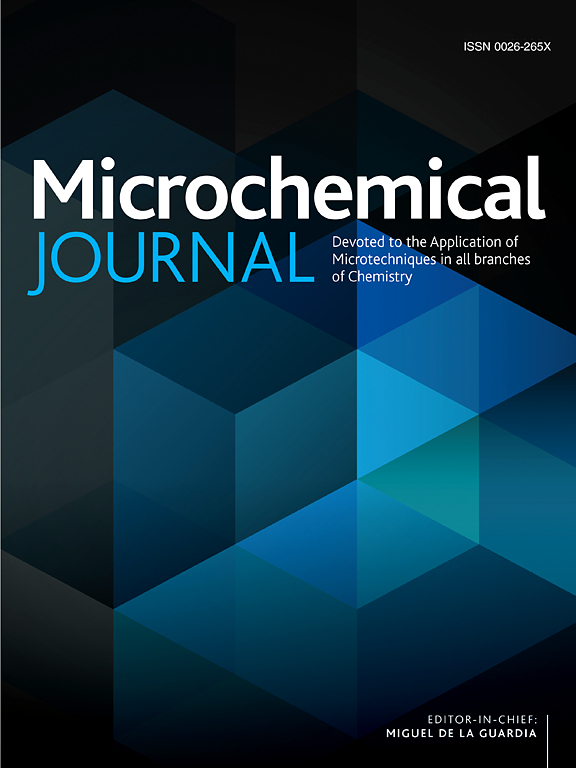Extraction of curcumin and curcuminoids: From conventional methods to innovative extraction using deep eutectic solvents
IF 4.9
2区 化学
Q1 CHEMISTRY, ANALYTICAL
引用次数: 0
Abstract
This review compares the methods for extracting curcumin and curcuminoids from turmeric (Curcuma longa L.) and focuses on the use of deep eutectic solvents as a new approach. Conventional techniques such as Soxhlet extraction and maceration, as well as advanced methods such as ultrasound-assisted, microwave-assisted, and supercritical fluid extractions, are examined. Each method is analyzed for extraction efficiency and yield of the curcuminoids. This review explores the influence of extraction parameters, such as temperature, time, and solid-to-solvent ratio, on extraction efficiency. The application of deep eutectic solvents offers significant advantages for enhancing extraction. These solvents offer superior yields, enhanced chemical stability, and increased environmental sustainability compared with conventional organic solvents. The integration of deep eutectic solvents with advanced extraction technologies, such as microwave- and ultrasound-assisted extraction, has the potential to further optimize the extraction efficiency while minimizing energy consumption. Additionally, the synergistic effect observed when combining supercritical fluid extraction with deep eutectic solvents may lead to substantial improvements in extraction yields over traditional solvent-based techniques. This review presents a comprehensive assessment of the extraction methods currently employed for curcumin and curcuminoids, emphasizing the promising role of deep eutectic solvents in the development of more efficient and sustainable extraction processes for future applications in pharmaceuticals, functional foods, cosmetics, and dietary supplements.
姜黄素和姜黄素的提取:从传统的方法到创新的提取,使用深度共晶溶剂
本文对姜黄中姜黄素和姜黄素的提取方法进行了比较,重点介绍了深共晶溶剂提取姜黄素和姜黄素的新方法。研究了索氏提取和浸渍等传统技术,以及超声辅助、微波辅助和超临界流体提取等先进方法。分析了各种提取方法对姜黄素的提取率和得率的影响。本文综述了萃取温度、时间、料液比等参数对萃取效率的影响。深共晶溶剂的应用为提高萃取效率提供了显著的优势。与传统的有机溶剂相比,这些溶剂的收率更高,化学稳定性更好,环境可持续性更好。将深层共晶溶剂与先进的萃取技术(如微波和超声辅助萃取)相结合,有可能进一步优化萃取效率,同时最大限度地降低能耗。此外,当超临界流体萃取与深度共晶溶剂结合使用时,观察到的协同效应可能会大大提高传统溶剂基萃取技术的提取率。本文综述了目前用于姜黄素和姜黄素的提取方法,强调了深度共晶溶剂在开发更有效和可持续的提取工艺方面的重要作用,在未来的制药、功能食品、化妆品和膳食补充剂中具有应用前景。
本文章由计算机程序翻译,如有差异,请以英文原文为准。
求助全文
约1分钟内获得全文
求助全文
来源期刊

Microchemical Journal
化学-分析化学
CiteScore
8.70
自引率
8.30%
发文量
1131
审稿时长
1.9 months
期刊介绍:
The Microchemical Journal is a peer reviewed journal devoted to all aspects and phases of analytical chemistry and chemical analysis. The Microchemical Journal publishes articles which are at the forefront of modern analytical chemistry and cover innovations in the techniques to the finest possible limits. This includes fundamental aspects, instrumentation, new developments, innovative and novel methods and applications including environmental and clinical field.
Traditional classical analytical methods such as spectrophotometry and titrimetry as well as established instrumentation methods such as flame and graphite furnace atomic absorption spectrometry, gas chromatography, and modified glassy or carbon electrode electrochemical methods will be considered, provided they show significant improvements and novelty compared to the established methods.
 求助内容:
求助内容: 应助结果提醒方式:
应助结果提醒方式:


